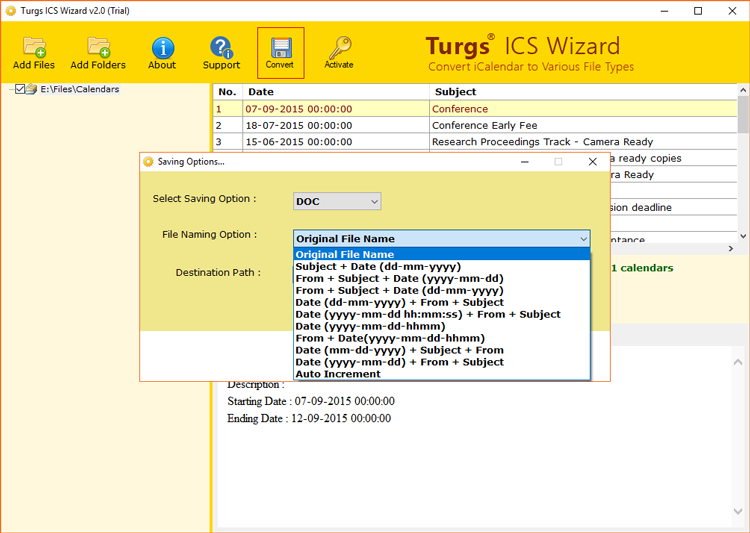
Enter your new calendar details and Create a calendar button. ics file, go to: setting and choose Add calendar. To create a new calendar that will use the. Select the calendar from which you want to import ICS events. Find and open the ICS file you want to use. Choose the option called Select a file on your computer where income part. Open Google Calendar at .Ĭhoose gear icon At the top of Google Calendar, to the left of your profile picture.Ĭhoose import export Select an option from the options on the left side of the screen.Ĭhoose income Under import export.

Import ICS calendar files into Google Calendar Here you can merge items into an existing calendar or display events in a new calendar within the application you are using. ics extension and then import them into your favorite calendars. You can export your calendar entries to an. As you can see in the above example the RECURRENCE-ID is a date and time of the specific instance in the recurrence set.The information in this article applies to Apple Calendar and Google Calendar, but most calendars support importing ICS files. In addition to UID every overridden instance has its own RECURRENCE-ID which identifies the instance that this component overrides. The uppercase and lowercase UID are treated as different ids. Important! iOS Calendar UID is case sensitive, it requires uppercase UID only. Typically this UID is also used as a calendar (.ics) file name. The above event with EXDATE in iCalendar format: BEGIN:VCALENDARĮXDATE TZID=America/Toronto:20170516T100000ĮXDATE TZID=America/Toronto:20170517T100000Īll components within an event/to-do share the same UID. Below you can see an example of the same event with 2 instances, on Tuesday and Wednesday, being deleted: The EXDATE property is called exception dates and can contain more than one exception date as every EXDATE property value. When you delete the event instance, the client application will add an EXDATE property for every event instance that was deleted with date and time of the instance that should not occur. RECURRENCE-ID TZID=America/Toronto:20170518T100000ĮND:VCALENDAR What Happens when You Delete a Recurring Event Instance? Note the 2 VEVENT components stored in it – the first one contains a recurring event description and the second one - event instance that was overridden by the client ("Final Meeting"). Here is its representation in iCalendar format.

Here is the example of the above event with the last instance summary being changed to “Final Meeting” and start time being set to 11:00AM: This new component contains information about updated event instance and has a RECURRENCE-ID property that stores date and time of the event instance.
#Ics file details update
When you change a separate event instance in your CalDAV client application, for example when you update the time or summary for a particular day, the client submits to the server the updated iCalendar object with a new component added to the event. What Happens when You Update an Instance of a Recurring Event? You can find more about calendar folders and calendar files in the Creating CalDAV Server article. ics file is represented by ICalendarFileAsync interface. Every calendar file (.ics file) on a CalDAV server stores a single event or to-do, even though the info about event/to-do is wrapped in “VCALENDAR” block. The calendar is a calendar folder and is represented by ICalendarFolderAsync interface. However when you update an event instance of a recurring event, more components are created, see below.ĭo not confuse the VCALENDAR object that you will find inside a. Below you can see this event in iCalendar format, you will find a single VEVENT definition in it: BEGIN:VCALENDARĭTEND TZID=America/Toronto:20170515T110000ĭTSTART TZID=America/Toronto:20170515T100000Ī non-recurring event or recurring event that does not have overridden instances consists of a single component. Note that it consists of a single event component. Below is an iPhone Calendar application with a recurring event that has 4 instances Monday through Thursday: You can see event/to-do instances when calendar is displayed in your client application. Recurring event/to-do expands to event/to-do instances. It also typically contains one or more time zone component.

Every event/to-do object consists of one or more event or to-do components. Event/To-do Components and InstancesĮvery calendar file stored on a CalDAV server contains a single iCalendar object with a single event or to-do defined inside it.
#Ics file details how to
To fond how to parse and generate iCalendar data read articles in the Using IT Hit Collab Library API section. This article describes how iCalendar data is stored on a CalDAV server.


 0 kommentar(er)
0 kommentar(er)
